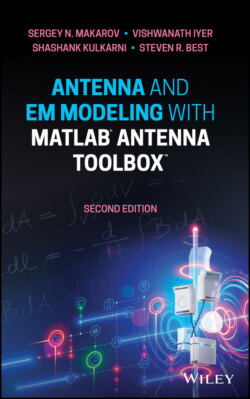Читать книгу Antenna and EM Modeling with MATLAB Antenna Toolbox - Sergey N. Makarov - Страница 38
1.11 REFLECTION COEFFICIENT EXPRESSED IN DECIBELS AND ANTENNA BANDWIDTH
ОглавлениеIt follows from the previous discussion that the major dimensionless parameter that characterizes antenna matching is the antenna reflection coefficient, Γ. To highlight the physical meaning of the reflection coefficient and its acceptable threshold, we rewrite Eq. (1.17) for the antenna power one more time:
(1.30)
and let |Γ|2 to have the value of 0.1. According to Eq. (1.30), this means that the power delivered to the antenna is exactly 90% of the maximum available antenna power. Simultaneously, the reflection coefficient in dB (or power reflection coefficient),
(1.31)
will attain the value of −10 dB. Since ideal antenna matching (|Γ|=0 or |Γ|dB = − ∞) is never possible over the entire frequency band, it is a common agreement that, if
(1.32)
uniformly over the band, then the antenna is said to be matched over the band. In other words, at least 90% of available power from the generator will be delivered to the antenna for any frequency within the band. When applied over a frequency band, Eq. (1.32) thus determines the antenna impedance bandwidth or simply the antenna bandwidth. Several such bands may be present for a multiband antenna.
The TX antenna may be treated as a one port (port 1) of an electric linear network, whereas the other ports (if present) are other antennas. An example is given by a transmit/receive antenna pair, which form a two‐port linear network. In that and similar cases,
(1.33)
where S11 is the port 1 complex reflection coefficient or the first diagonal term of a multi‐port scattering matrix [1]. Similarly, Eq. (1.32) may be written in the form:
(1.34)
